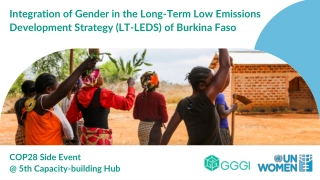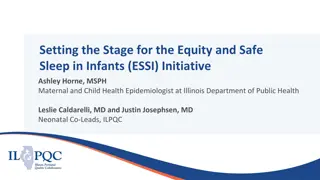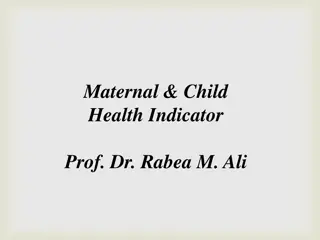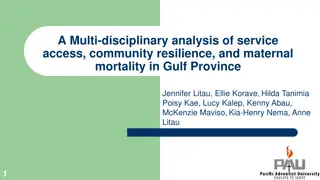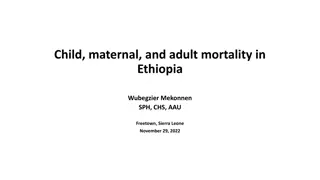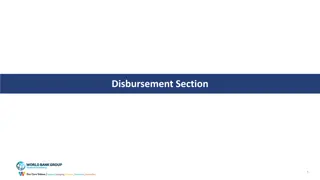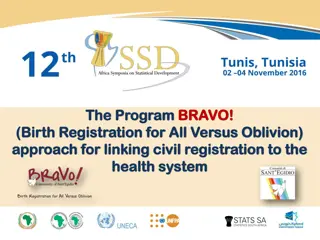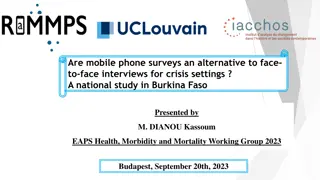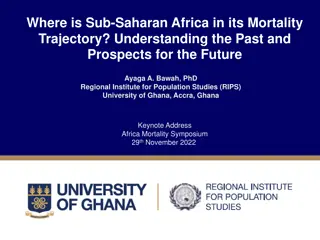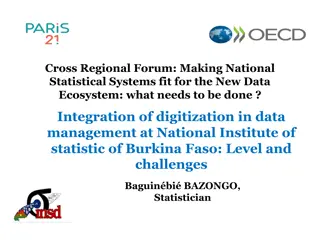Measuring Child Mortality from Mobile Phone Surveys in Burkina Faso: Security Challenges Assessment
Burkina Faso faces challenges in data collection due to security issues impacting healthcare access and mortality rates. This study explores using Mobile Phone Surveys (MPS) to measure child mortality in crisis contexts and compares it with traditional methods.
Uploaded on Mar 15, 2025 | 2 Views
Download Presentation

Please find below an Image/Link to download the presentation.
The content on the website is provided AS IS for your information and personal use only. It may not be sold, licensed, or shared on other websites without obtaining consent from the author.If you encounter any issues during the download, it is possible that the publisher has removed the file from their server.
You are allowed to download the files provided on this website for personal or commercial use, subject to the condition that they are used lawfully. All files are the property of their respective owners.
The content on the website is provided AS IS for your information and personal use only. It may not be sold, licensed, or shared on other websites without obtaining consent from the author.
E N D
Presentation Transcript
Measuring child mortality from mobile phone surveys in countries facing security challenges: an assessment in Burkina Faso Presented by Kassoum DIANOU Living Standards Measurement Study (LSMS) & USAID Hybrid Conference 17 18 December 2024, Washington D.C, USA
Context Burkina Faso faces significant challenges in data collection due to security issues This situation affects access to : Healthcare Nutrition, Creates disparities in mortality rates Assessing the true extent of these impacts is difficult Surprisingly, child mortality trends in Burkina Faso In this context, there is an urgent need for faster, more cost-effective, and flexible data collection methods to bridge the gap between major household surveys and situations where face-to-face methods are impractical.
Mobile Phone Survey (MPS) Advantages: Some concerns: Low cost Low response rate? Potentially broader Data quality challenges geographical coverage Selection bias Faster operationalization Inability to capture certain indicators Greater anonymity Network quality
MPS in SSA Africa has seen a rise in MPS : Assessing health interventions and monitoring demographic events Evaluate impacts on household living conditions Preventive behaviors Child nutrition indicators Few MPS have been conducted in areas affected by both security and health crises, and even fewer have focused on collecting mortality data Most studies conducted during conflicts rely on face-to-face data collection, with very few utilizing phone surveys. This study aims to assess the feasibility of using MPS to estimate child mortality and identify the advantages of this approach over traditional face-to-face surveys in contexts of health and security crises
Data and methods : RaMMPS data collection in Burkina Faso Two sampling strategies : (1) Use of pre-existing telephone numbers (EHCVM pour Enqu te Harmonis e sur les Conditions de Vie des M nages) (2) RDD filtered with the support of Viamo (RDD) Data collection period : 09/2021-10/2022 Target population : 15-64 years old, residing in Burkina Faso Prior to their interview each respondent gave their verbal informed consent to participate. Standard procedures were followed, including comprehensive training, consistent supervision, and refresher courses for enumerators to maintain data quality.
High-Frequency Phone Survey (HFPS) 2020-2024 The High-Frequency Phone Survey (HFPS) in Burkina Faso, conducted from June 2020 to July 2024 The survey is a follow-up to the 2018/19 Harmonized Survey on Household Living Conditions (EHCVM) It targeted 1,800 households, eventually contacting 2,500, with 1,968 households interviewed in the first phase. To ensure national representation, especially in rural areas, additional households were included in later phases Each month, the same households were re-contacted via mobile phones Pre-loaded household data helped interviewers accurately identify and track households across survey rounds, maintaining the integrity and continuity of the panel.
Methods Compare the characteristics of the HFPS and RaMMPS survey samples, with a focus on the EHCVM branch Under-Five mortality indicators Poisson regression models: analyze the relationship between mortality and food security status. Post-stratification weighting
U5MR by data source RDD = DHS EHCVM > DHS
Effects of household and mother characteristics on mortality differentials Factors significantly influencing mortality levels Regional security context, Mother education level, Migration status
Discussions and conclusion MPS offer a viable alternative to traditional surveys for estimating child mortality, particularly in insecure regions where conventional methods are impractical. MPS can capture critical mortality trends, especially in high-risk areas, that face- to-face surveys might miss. The findings underscore the heightened vulnerability of households in insecure regions to food insecurity and its link to elevated child mortality rates. Policymakers should consider integrating MPS into national data collection strategies to ensure comprehensive and timely information, especially during health and security crises.
Thanks for your attention Kassoum DIANOU Email: kassoum.dianou@uclouvain.be / kassdianou@gmail.com Tel: (0032) 476 311445/(+226) 71409873



